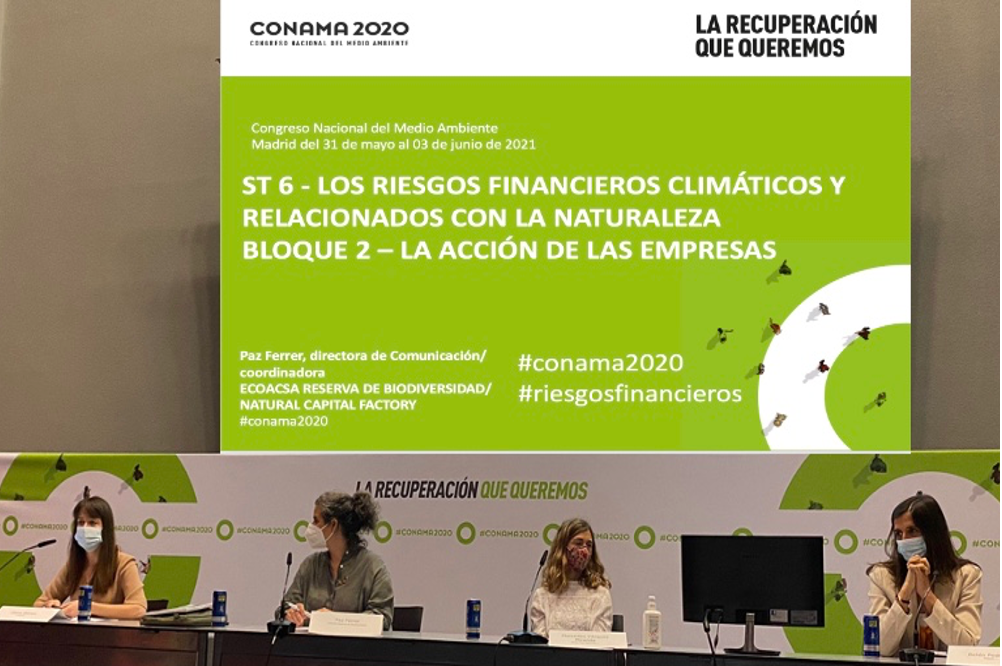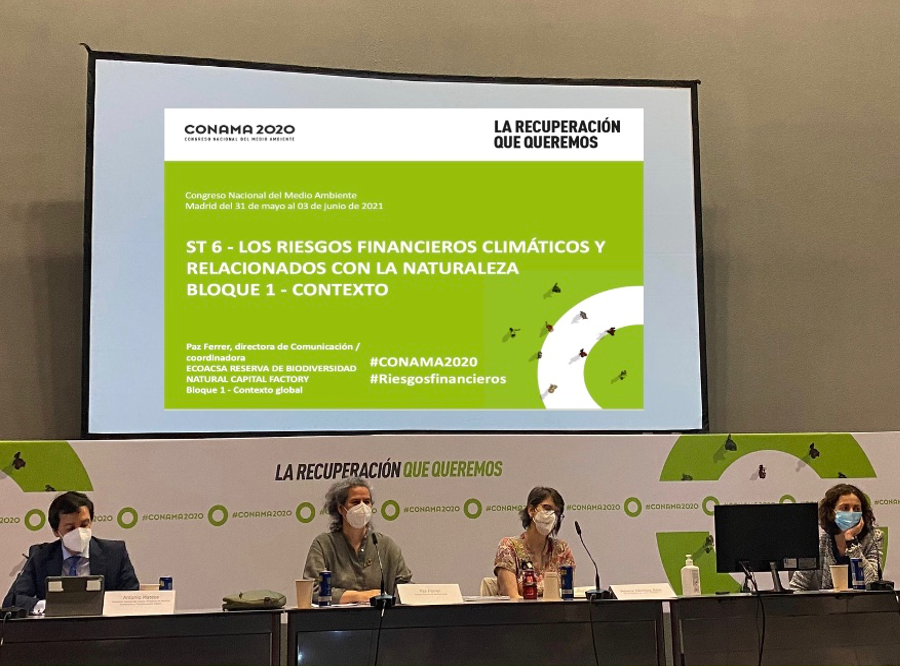Block 2 of CONAMA 2020’s Technical Session 6 was focused on the presentation of the results of the survey launched by CONAMA’ Technical Committee 6 on how Spanish organizations address climate and nature-related financial risks and how they contribute to adaptation to climate change and the strengthening of social resilience. In addition, Elena Blanco Lozano, Manager of Sustainability and Environment of Enagás, Mercedes Vázquez Miranda, of the Sustainability Department of the Grupo Red Eléctrica, and Belén Pedruelo Gárate, Manager SR Reporting ESG of Repsol shared with the attendees real cases about their experience managing these risks in their respective companies.
Paz Ferrer Calvo, Communication Director of Ecoacsa and coordinator of the Natural Capital Factory, shared with the attendees some of the most relevant conclusions obtained from the consultation (read the technical document published by CT6):
- Most of the companies participating in the consultation are aware of the types of climate and nature-related financial risks, although the latter are known to a lesser extent.
- The main reason cited for starting to manage climate and nature-related financial risks is alignment with global commitments such as the SDGs and the Paris Agreement.
- The main challenge when it comes to managing climate-related financial risks is the lack of availability of metrics, while in the case of managing nature-related financial risks it is the necessary collaboration between different actors or the need to improve existing collaboration.
Relevant climate and nature-related financial risks
Some examples of physical climate-related financial risks identified by the companies that answered to the consultation are the increase in the frequency and severity of adverse phenomena that affect livestock, agriculture, aquaculture and forestry activities, risks associated with droughts that compromise the productive activity, the decrease in water resources, delayed deliveries due to a higher frequency of floods, and the loss of biodiversity, with consequences on the health of people and animals.
Among the most relevant transition climate-related financial risks are CO2 prices and the greater difficulty in raising funds to finance the development of certain projects. This is derived from the position that the financial sector or investors with exposure to the energy sector may adopt, whether voluntarily or induced by the regulator. Additional climate-related financial risks are legal breaches in environmental issues that translate into fines with consequent reputational damage.
Some of the most relevant physical financial nature-related risks for companies participating in the survey are legal restrictions on animal life, animal husbandry, animal health, use of veterinary medicine, emerging diseases that affect animals and people, and problems related to food security.
Regarding key transition financial nature-related risks, some are related to litigation derived from the loss of biodiversity and breach of legal frameworks such as non-compliance with applicable environmental legislation and environmental requirements (including fines or sanctions), the absence of environmental permits and authorizations and protests of the neighbors due to the effect that the activity of the company causes on the environment, flora or fauna.
Barriers to promoting adaptation to climate change
With the aim of supporting the general objective of the National Climate Change Adaptation Plan 2021-2030, the survey included a series of questions to find out how Spanish organizations contribute to adaptation to climate change, what obstacles they encounter when promoting it and what would be needed to change. Among the main obstacles are:
The lack of resources specifically earmarked for this objective. The very long-term return on stocks and investments and the uncertainty in the production of damages. Operationally there are no obstacles. Both the market and short-term profit are levers of change. The biggest obstacle is the business model. The involvement of the different areas of the company, being a cross-cutting issue and with a high technical knowledge required. The vision of the companies is still somewhat short-term. Most of the budget of companies is focused on mitigation. Regulatory framework with shortcomings.
In relation to what is necessary to enable organizations to act as levers of adaptation to climate change, the organizations that responded to the query identified:
- Reviewing of the economic criteria for evaluating investments.
- Externalities must be considered.
- Tax incentives or levies, stable policies and legal obligations.
- Collaboration: the sharing of the work of the companies with the Administration would be interesting. Thus, initiatives carried out in the private sphere could enrich common work (and vice versa).
- Easy-to-use sectorial tools, disseminated in working groups and forums through explanatory videos on their use.
- Establishment of communication channels between companies and experts on the subjec
- The incorporation of probable risks in the estimates of the operating accounts.
Management of climate-related risks and opportunities in Grupo Red Eléctrica
Mercedes Vázquez Miranda, del Departamento de Sostenibilidad del Grupo Red Eléctrica, explicó que su compañía publicó en 2011 su compromiso en materia de cambio climático, que incluía la adaptación como una de las áreas clave identificadas en las que trabajar. Por eso, se realizó en 2012 un estudio de gestión de riesgos climáticos en las infraestructuras de transporte de electricidad. Este estudio ha servido de base para llevar a cabo un seguimiento y revisión anual de los riesgos y también para trabajar en la integración de esta gestión en la gestión global de riesgos de la compañía. Finalmente, entre 2019 y 2020, se ha llevado a cabo un proyecto muy específico de adaptación a las recomendaciones del Task Force for Climate Financial Disclosures (TCFD) y se ha incorporado completamente esta gestión en la gestión global de riesgos y se ha revisado completamente el sistema de identificación, evaluación y monetización de los riesgos y oportunidades del cambio climático.
According to Vázquez Miranda, the climate risk quantification exercise has been very complex and has practically required the development of a methodology for each of the risks and opportunities because the impacts are very diverse.
Some opportunities, physical and transition climate and nature-related financial risks that have the greatest impact on Grupo Red Eléctrica are:
Physical finance risks
- Impact on outdoor facilities (lines) by extreme events (winds).
- Fires under the lines, not generated by them, but that can affect them because they can occur under these lines and in the surroundings of substations greatly affecting the reputation.
- Corrosion in facilities.
Transition finance risks
- Claims for limitations on renewable production and incidents that may affect the security of supply (Canary Islands), associated with the increase in the share of renewables in the energy mix.
- Not being able to build all the infrastructures necessary to meet the goals of the energy transition in 2030.
- Loss of firm generation associated with the closure of coal, combined cycle and nuclear power plants
Opportunities
- New services and products that will be required for the massive integration of renewables, such as potential construction of storage systems in island systems.
- Reputation improvement associated with good performance on climate change: share price increase.
- Reputation improvement associated with good performance on climate change: financial opportunities linked to projects in green bond schemes.
"None of the financial impacts derived from these risks has exceeded 2% of the company's annual result, so they are not as relevant as could have been initially expected thanks to adaptation measures that are being implemented. For example, a lot of work is being done on specific wind maps by zones in the case of wind risk, the review of the construction parameters that can reinforce the lines in some places, the meshing of the electrical network is a fundamental measure to avoid problems and insurances, which are also very relevant."
Climate change and nature management in Enagás: Opportunities and risks
Elena Blanco Lozano, Enagás Sustainability and Environment Manager began her presentation by recalling that the context of the pandemic has revealed the existence of other crises that we face and their relationship of dependence on nature. In addition, she pointed out that in recent years there has been an evolution of global risks to place environmental risks among the most relevant in terms of probability of occurrence and impact on the safety of the population of the latest editions of the World Economic Forum’s Global Risks Reports .
When evaluating and identifying action areas related to Enagás’ material issues, evaluation methodologies from their management systems are used, certified by ISO standards, and an impacts and dependencies assessments is carried out following the Natural Capital Protocol. These assessments serve as the basis for conducting risk assessments derived from climate change and biodiversity loss according to different scenarios and contexts. These evaluations are developed in direct operations, value chains and investee entities and their results are used when analyzing new business opportunities, detailed the manager of the Spanish gas transportation system.
“We are beginning to develop the valuation of ecosystem services at facility level, monetizing the impacts on biodiversity to calculate the net debt of natural capital with the intention that nature is integrated into the management variables of the company, to direct and prioritize actions more efficiently when conserving and restoring ecosystems.”
Enagás also carries out environmental monitoring plans, environmental impact assessments, energy consumption assessments and environmental monitoring plans within the framework of management systems. Regarding impacts and dependencies assessment, Enagás has conducted an exercise at global facility levels. The main dependencies on natural capital and the impacts identified on it are:
Dependencies
- Gas and electricity energy consumption (abiotic supply resources).
- Soil dependence affecting ecosystem services such as land stabilization and erosion control.
Impacts
( construction phase)
- Alteration of vegetation cover when opening tracks to build gas pipeline sections.
- Temporary modifications in the behavior of species
- Modification of the landscape.
(operation and maintenance phase)
- Greenhouse emissions.
- Waste generation.
- Water consumption.
- Acoustic pollution.
- Light pollution.
These evaluations serve as “inputs” to develop risk assessments. In this sense, Enagás has identified the main climatic and nature-related financial risks, considering the protected spaces and species and the value of natural capital:
Climate-related financial risks
(strategic)
- Rol del gas natural en el mix energético
( transition)
- Loss of income due to lower demand and operating costs derived from the rise increase of CO2.
(físicos)
- Additional operating costs due to natural disasters.
Nature-related financial risks
( transition)
- Sobrecostes operativos por impactos en biodiversidad.
(legal)
- Loss of income as a consequence of policies that may limit land occupation for new infrastructures.
Measures and actions aimed at minimizing risks
Some of the measures and actions that Enagás is implementing to minimize these risks consist of adopting the objective of being a carbon neutral company by 2040, achieving by 2030 No Net Loss of biodiversity during construction and in the facilities it operates, compensating emissions that cannot be avoided through reforestation projects and the commitment to apply nature-based solutions to preserve, restore and manage ecosystems and species. Other additional measures adopted by Enagás to reduce climate and nature-related financial risks are the incorporation of environmental criteria in due diligence processes, environmental certifications and emission reduction targets linked to variable remuneration, concluded Elena Blanco Lozano.
Climate-related risks management in Repsol
Repsol carries out a detailed analysis of the TCFD requirements on an annual basis and applies visual management (using colours) to assess the degree of compliance. The working group created to address climate-related financial risks agrees on the criteria and gaps that require management in a different way or that is necessary to address and defines the roadmap to comply with the recommendations of the TCFD. This roadmap is later validated by the Risk Committee, the expert pointed out.
The responsibilities and functions in risk management of committees and divisions involved in governance have had to be defined in detail. In terms of risk management, in 2018 the Risk Division led the first internal study of emerging risks from climate change, expanding the scope of the analysis of these risks according to a long-term time horizon (2050). For this, it was necessary to develop a long-term risk assessment methodology applicable to emerging risks to climate change, which are not usually addressed in companies’ risk analysis. This methodology was published for the first time in 2018 and work is continues to update the risks map.
As Pedruelo Gárate explained, climate reference scenarios considered by Repsol’s roadmap are those scenarios considered by the International Energy Agency for 2030 and 2050. In addition, to support the company’s risk strategy, there are a series of tools and mechanisms:
- Setting ambitious short- and long-term decarbonization targets and encouraging their fulfillment.
- Commitment to being a net zero emissions company by 2050, in line with the Paris Agreement to guide our progressive transformation into an energy company that evolves according to global needs; with intermediate objectives consistent with our business plans.
- An internal carbon pricing mechanism applied to investment decision making.
In terms of business, according to the Repsol manager, work is being done on:
- The incorporation of new capacities (for example, wind and solar) to move towards a low-carbon electricity generation business with growth objectives.
- The development of low carbon fuels (advanced biofuels, biogas from organic waste and synthetic fuels).
- Circular economy, to incorporate more recyclable products.
- Transformation of the Exploration and Production portfolio prioritizing assets with short life cycle and less carbon intensive.
- Increase energy efficiency opportunities in industrial assets.
- The diversification of service stations towards less carbon mobility.
To conclude, Belén Pedruelo mentioned a series of good practices that are helping internally to advance in the most adequate management of risks. Among them, she highlighted “the areas involved, the definition of the work methodology – which has helped to make significant progress -, the commitment of upper management and transparency to stakeholders -.
“The next steps that we will take to advance in better management of climate and nature-related financial risks will be to work on improving their quantification through indicators, applying the EC's sustainable finance taxonomy and closely monitoring the work of the Task Force for Nature-related Financial Disclosure (TNFD).”








No Comments
Sorry, the comment form is closed at this time.